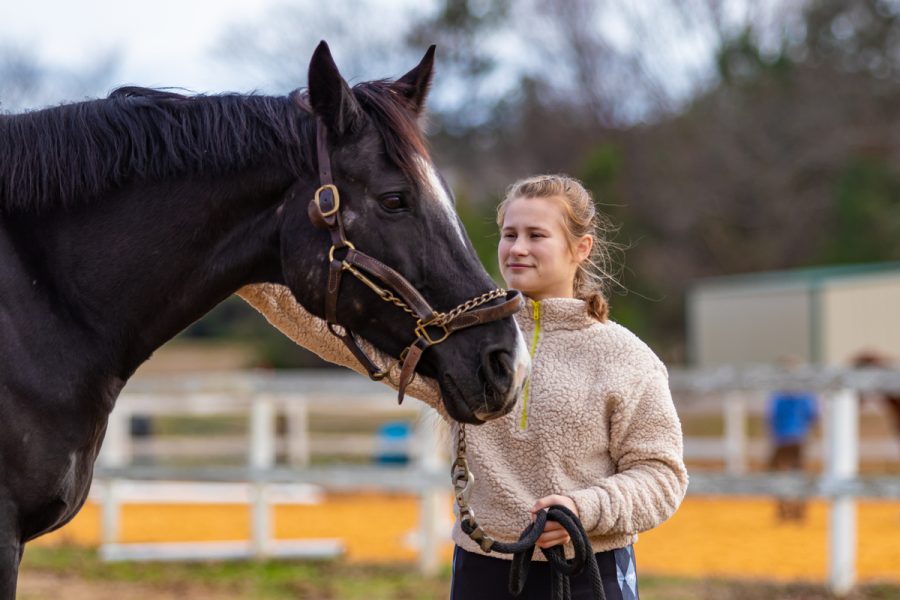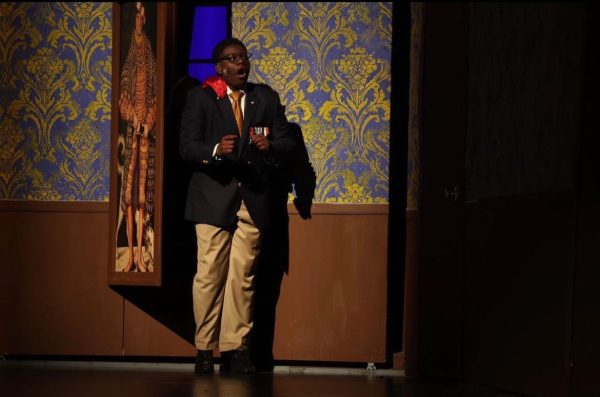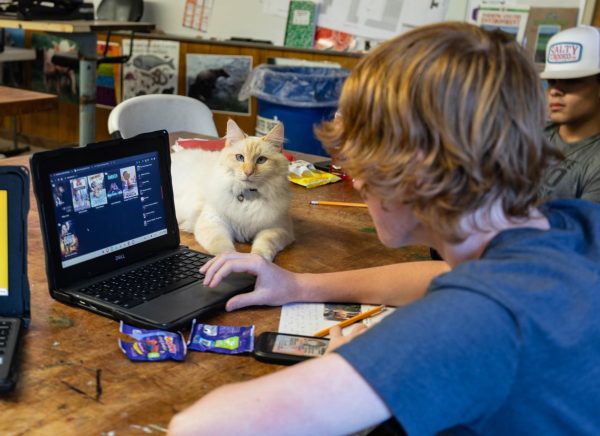Saddling up for success
Dressage competitor Macy Sloan describes the challenges of competing in a marginalized sport
Junior Macy Sloan pets her horse, Jazz. Sloan has participated in competitive dressage events for the past four years.
January 10, 2020
Training an animal triple one’s size to move gracefully with just a pull of the reigns is no easy feat. When the movements are scrutinized by a panel of judges who are trained to notice every mistake, the process becomes even harder. Junior Macy Sloan takes on the challenge every time she saddles up for dressage competitions.
For many, dressage seems completely foriegn. The sport originated in Europe, and for those in the South, opportunities for dressage are limited at best. Competitors like Sloan are used to explaining the sport and its intricacies to those completely unfamiliar with dressage.
“It’s like horse ballet, with the horse doing the movements,” Sloan said. “That is the best common word explanation I can think of. Your goal is to complete a series of specific movements.”
Most people are quick to associate any equine-based sports with the rodeo, which is much more common in the South. But Sloan is quick to point out how dressage is different than the rough and fast-paced sport so many are used to.
“To compete, you have a series of tests. Each test is a series of patterns that you and the horse must complete,” Sloan said. “You start out with a simple circle. Then, it moves to trotting and cantering in specific paths. It gets more complicated from there, with figure-eights and leg-yields.”
Since competitive dressage isn’t what most would consider typical for the area, very few are introduced to the sport in their youth. Sloan was an exception, and taking early to the sport is what gave her a competitive edge.
“[I started dressage] in the sixth grade. I had just joined Texas Middle School but didn’t really know anyone or join any clubs, so I had a lot of extra time,’ Sloan said. “And since I always liked horses going back to Elementary school, my dad started looking at places for me to ride.”
Considering the scarcity of dressage in the area, it is a challenge for many to find places to train for this particular type of riding. Western forms of riding dominate the majority of stables in the area, making it difficult for those in dressage to find anywhere dedicated to their niche.
“I used to do Western riding, which is wildly different,” Sloan said. “But I was lucky when my dad found an English riding stable. I gave it a try and I’ve stayed there at Red River Riding Academy since sixth grade.”
Like any competitive sport, there are rigorous standards to be met. In dressage especially, much of the competition will involve specific formal uniforms that make riders stand out.
“[Uniforms] depend on which level you are competing at,” Sloan said. “If you’re really new, you can wear chaps, tall boots or polos. At my level, I have ‘show shirts’ which are sold at shows that I go to. You can make your uniform as fancy or as dull as you want.”
While uniforms are an important component to the sport, dressage is more than dress-up. An average competition is tiring, stressful and competitive like any other sport. Over the years, Sloan developed a process to prepare for every competition. The horses can make this process difficult if they have a hard time adjusting to the new environment, possibly lashing out or ignoring commands.
“I will usually leave the day before so [my] horse can get used to the arena,” Sloan said. “Horses are kind of like toddlers that are prone to temper tantrums. When they see a new thing, it can be really scary, but unlike toddlers, horses can kill you.”
Tensions run high at the showgrounds for the horse and its equestrian. On competition days, part of the challenge is managing the stress the rider and horse face.
“Show days are chaotic. There a lot of horses crowding the area,” Sloan said. “[Everyone’s goal] is just not to run into each other. There is a lot of yelling. Once you feel like you are warmed up, it’s showtime.”
During a competitor’s test, scoring is all up to the judges. Riders like Sloan can only trust in their training from this point and hope all of the elements of a good performance come together when it is time for the judges to decide their fate.
“Each movement can be scored from one through ten,” Sloan said. “A one is like ‘What are you doing? That isn’t even close.’ A ten could mean ‘I wish I got that on film.’ Once you are scored for every movement, scores are compared to see who goes home with a blue ribbon.”
When luck and preparation come together for Sloan, she has a shot to leave with first place. Many times, she has come out on top; after years of competing, she holds an impressive track record.
“I don’t want to sound pretentious, but I usually do pretty well,” Sloan said. “There are not many shows where I’m left completely disappointed with the results. Usually, I’ll get first or second, depending on how the day was. For the past couple years, I’ve gotten champion, but it depends on the show.”
Similar to any competition, there will always be an element of uncertainty. For Sloan, there have been many occasions where freak incidents or tough competition prevents her from performing her best.
“There are a lot of factors that can go bad,” Sloan said. “Once, my old horse refused to go through a puddle, and the judge had to coach me how to deal with it. Another time at competition, I was left only one test away from advancing. These things can definitely be frustrating.”
Even taking into account these unfortunate scenarios, Sloan loves the sport and plans to continue competing. The sport’s scarcity in the South can be challenging, but Sloan is optimistic of its future.
“[Dressage’s small presence] is really unfortunate because there are so many people around here who would really enjoy it,” Sloan said. “But, the more it gets offered, the more people who get interested, so it is growing. But I still wish it would get more representation in the South.”




















